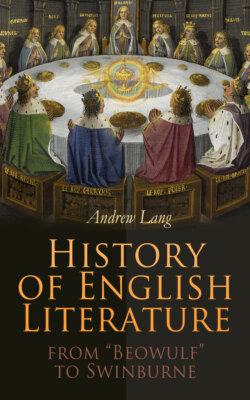Читать книгу History of English Literature from "Beowulf" to Swinburne - Andrew Lang, Robert Kirk - Страница 45
CHAPTER VII.
THE ROMANCES IN RHYME.
ОглавлениеWhen romance "is in," and, after Geoffrey of Monmouth, romance was in, every other kind of literature "is out"; is unfashionable and little regarded. The English rhyming chroniclers, and even religious writers such as the author of the "Cursor Mundi," felt constrained to make their works resemble fiction as nearly as possible; owing to the supremacy of French romances and English translations and adaptations of French romances, in the late twelfth, thirteenth, and fourteenth centuries.
Many of these productions grouped themselves round the Table of King Arthur, "matter of Britain"; others dealt with "matter of Rome," that is all the ancient world; others with "matter of France"; others with legends or fancies, English or foreign. Their subject was often the chivalrous theory and practice of love, as a kind of religion, a fantastic semi-idealized devotion to the beloved, who, as a rule, was another man's wife. This breach of recognized religion and morality was often set down to fate, to the power that the Anglo-Saxons named Wyrd.
The two greatest cycles of romantic love are found in the lives of Tristram and Iseult (the wife of King Mark of Cornwall, and aunt by marriage of Tristram), and of Lancelot and Guinevere, the wife of King Arthur. Tristram (whose name seems to be altered from the Welsh name Drysdan), has but little original connexion with the Court of Arthur, though he is a mythical hero of a very old Welsh "triad". He and Iseult love each other because they have by mischance drunk together of a love potion intended for Mark and his wife; their love is fatal and inevitable, and immortal.
Lancelot, on the other hand, has been sent to bring the bride Guinevere to Arthur, and they fall in love before the lady has seen her lord. Every one knows their joys and sorrows, from Malory's "Morte d'Arthur," (1470)—a prose selection and compilation of "the French books," which excels them and supersedes them—and from the poems of Tennyson, Matthew Arnold, and Mr. Swinburne.
The romances of love and tournament are pervaded and darkened by the influence of the Celtic Merlin, the enchanter and prophet whom men call Devil's son; he represents Destiny. A wide circle of romances, "Merlin" and the "Suite de Merlin," attributed to Robert de Borron, at the end of the twelfth century, are concerned with him.
As if to counteract the fanaticism of love which, in the romances, becomes a non-moral counter-religion, the mysterious story of the Holy Grail came into literature, French, German, and English. The Grail is perhaps originally one of the many magical things of Celtic legend, a vessel as rich in food inexhaustible as the purse of Fortunatus in gold, but conceived by the romance writers to be a mystic dish or cup, used by our Lord before His passion, and still existing, but only to be seen by the pure of heart, such as Sir Percival, and Sir Galahad, the maiden son of Lancelot.
By accident or design the romances fall into a tragic sequence: the youth of Arthur, and his unconscious sin; the mysterious birth of Merlin; the fatal loves of Lancelot and Guinevere; the coming of the Grail and the search for the Grail by many knights; the failure of all but Galahad and Percival; the falling of Lancelot and Guinevere to their old love again; and the sorrows and treacheries that precede and lead up to the king's last battle in the west, and his passing to Avilion.
France and Ireland, like England, have their own romances on the adventures of knights under the feudal sway of a chief king; in France, Charlemagne; in Ireland, Conchobar or Fionn; in England, Arthur, and in all these cases the king becomes much less interesting than his knights, such as Roland and Oliver in France; Cuchulain and Diarmaid in Ireland; Lancelot, Tristram, Gawain, and Percival in England. Yet Arthur, at first and at the last, is the supreme as well as the central figure in the epic, or cycle, of romances. These are a great treasury of brilliant imaginations, rising from Celtic traditions of unknown antiquity, and then transfigured, first by the chivalrous counter-religion of love; next by the reaction to celibacy, and the yearning after some visible and tangible Christian relic and sign, "the vision of the Holy Grail". From this hoard of mediaeval fancies later poets have taken what they could, have placed the jewels in settings of their own fashioning.
The romance writers were by no means restricted to "matter of Britain," with Celtic traditions; or to "matter of France," the epics of Charlemagne and his peers, or even to "matter of Rome," ranging through all antiquity. Material came in from popular tales of all countries, and from recent historical events, as in the romance of Richard Cœur de Lion. In the fifteenth century there was a romance of Jeanne d'Arc, as fantastic as any; the matter of it survives partly in the prose of the "Chronique de Lorraine," and has drifted into "Henry VI," Pt. I. In France the most famous and fashionable novelists of the late twelfth century were Chrétien de Troyes and Benoît de Ste.-Maure, author of the great romance of Troy, whose manner, long-winded and elaborately courtly, was strangely revived by the French romancers of the years preceding Molière.
